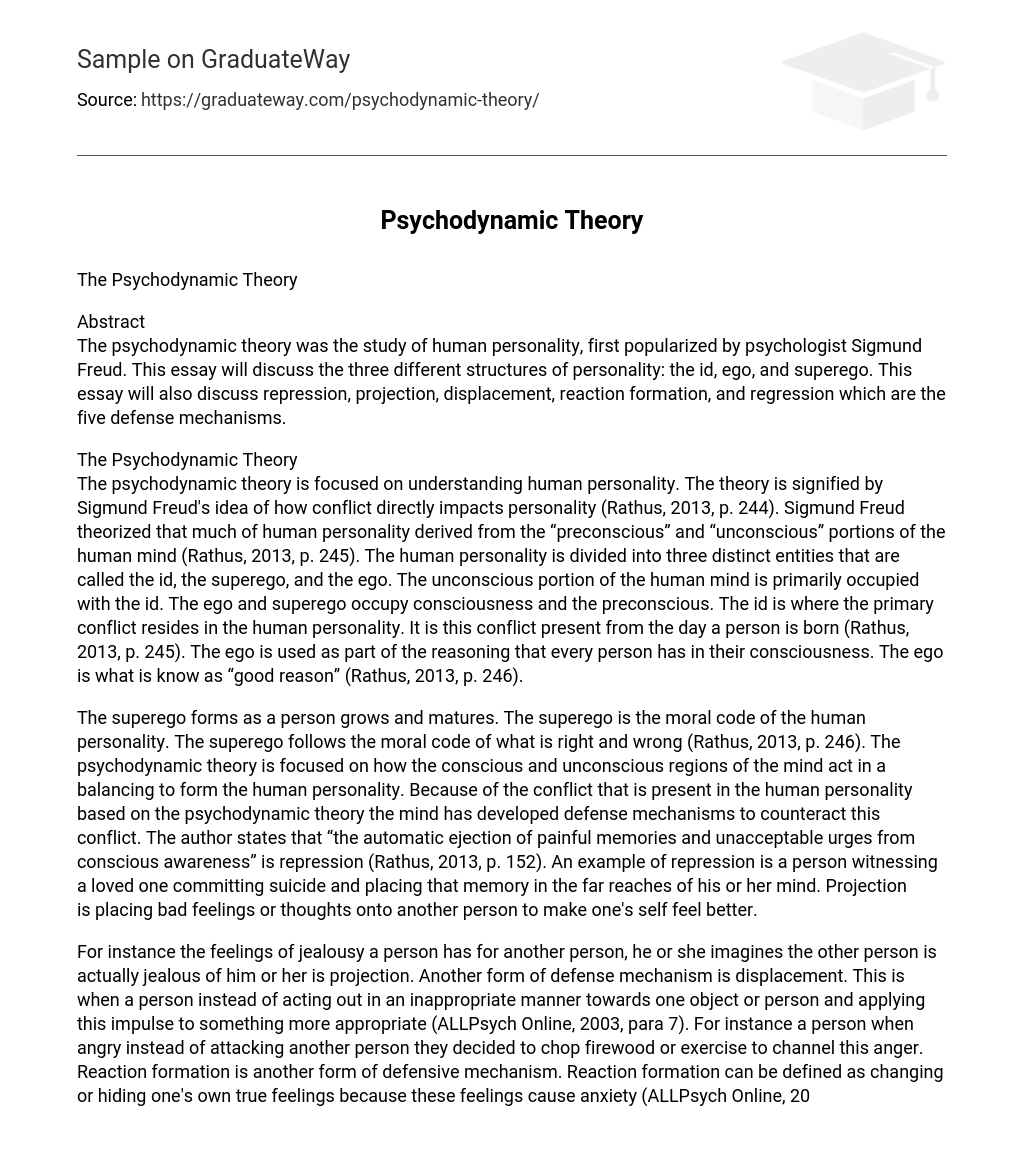Abstract
The psychodynamic theory was the study of human personality, first popularized by psychologist Sigmund Freud. This essay will discuss the three different structures of personality: the id, ego, and superego. This essay will also discuss repression, projection, displacement, reaction formation, and regression which are the five defense mechanisms.
The Psychodynamic Theory
The psychodynamic theory is focused on understanding human personality. The theory is signified by Sigmund Freud’s idea of how conflict directly impacts personality (Rathus, 2013, p. 244). Sigmund Freud theorized that much of human personality derived from the “preconscious” and “unconscious” portions of the human mind (Rathus, 2013, p. 245). The human personality is divided into three distinct entities that are called the id, the superego, and the ego.
The unconscious portion of the human mind is primarily occupied with the id. The ego and superego occupy consciousness and the preconscious. The id is where the primary conflict resides in the human personality. It is this conflict present from the day a person is born (Rathus, 2013, p. 245). The ego is used as part of the reasoning that every person has in their consciousness. The ego is what is know as “good reason” (Rathus, 2013, p. 246).
The superego forms as a person grows and matures. The superego is the moral code of the human personality. The superego follows the moral code of what is right and wrong (Rathus, 2013, p. 246). The psychodynamic theory is focused on how the conscious and unconscious regions of the mind act in a balancing to form the human personality. Because of the conflict that is present in the human personality based on the psychodynamic theory the mind has developed defense mechanisms to counteract this conflict. The author states that “the automatic ejection of painful memories and unacceptable urges from conscious awareness” is repression (Rathus, 2013, p. 152). An example of repression is a person witnessing a loved one committing suicide and placing that memory in the far reaches of his or her mind. Projection is placing bad feelings or thoughts onto another person to make one’s self feel better.
For instance the feelings of jealousy a person has for another person, he or she imagines the other person is actually jealous of him or her is projection. Another form of defense mechanism is displacement. This is when a person instead of acting out in an inappropriate manner towards one object or person and applying this impulse to something more appropriate (ALLPsych Online, 2003, para 7).
For instance a person when angry instead of attacking another person they decided to chop firewood or exercise to channel this anger. Reaction formation is another form of defensive mechanism. Reaction formation can be defined as changing or hiding one’s own true feelings because these feelings cause anxiety (ALLPsych Online, 2003, para 11). For example a person that has a pornography addiction but instead on the outside to the world displays a very strong anti-pornography stance. Regression is when a person returns to a previous stage of development cause by anxiety (ALLPsych Online, 2003, para 12).
For instance a person that begins to feel high levels of anxiety might begin to cry and revert back to the behavior of a small child. The psychodynamic theory and defense mechanism all play a crucial role into the understanding of human personality. Theory shows how the idea of conflict in human unconsciousness is thought to factor into personality. The five defense mechanisms show how people can react to when they encounter different levels of stress. Depending on a person’s personality can also play a role into the defense mechanism they use.
References
- Rathus, S. (2012) Psych Student Edition (3). Wadsworth, Cenage Learning. (174-175).
- ALLPsych Online: The Virtual Psychology Classroom. (1999-2003) Psychology 101: Ego defense mechanisms. Retrieved from http://allpsych.com/psychology101/defenses.html





